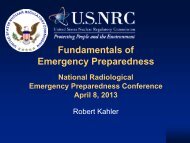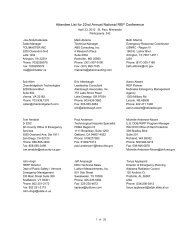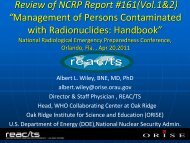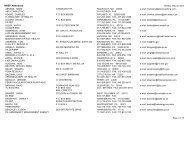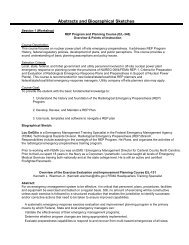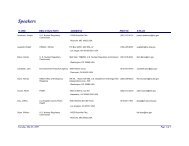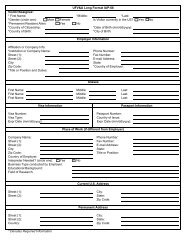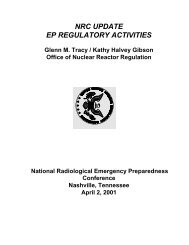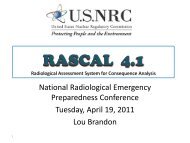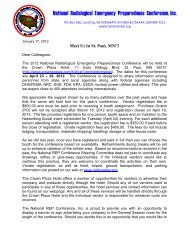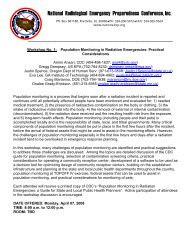Session 3_NRC Fundamentals of Emergency ... - National REP
Session 3_NRC Fundamentals of Emergency ... - National REP
Session 3_NRC Fundamentals of Emergency ... - National REP
You also want an ePaper? Increase the reach of your titles
YUMPU automatically turns print PDFs into web optimized ePapers that Google loves.
<strong>Fundamentals</strong> <strong>of</strong><br />
<strong>Emergency</strong> Preparedness<br />
<strong>National</strong> Radiological <strong>Emergency</strong> Preparedness<br />
Conference<br />
April 18, 2011<br />
Bob Kahler<br />
Branch Chief<br />
Office <strong>of</strong> Nuclear Security and Incident Response
Presenter<br />
• Bob Kahler, Branch Chief<br />
• NSIR/DPR/IRIB<br />
• Office <strong>of</strong> Nuclear Security and Incident<br />
Response (NSIR)<br />
– Division <strong>of</strong> Preparedness and Response<br />
(DPR)<br />
• <strong>Emergency</strong> Preparedness<br />
– Inspection and Regulatory Improvements Branch<br />
(IRIB)<br />
2
Meet your presenter…<br />
• <strong>NRC</strong><br />
– 2001 to Present<br />
• Beaver Valley Power Station<br />
– 1981 to 2000<br />
– EP Manager<br />
– Simulator/Classroom Instructor<br />
– SRO license on both units<br />
• Shippingport Atomic Power Station<br />
– 1979 to 1981<br />
– Reactor Operator<br />
3
Workshop Overview<br />
• Role <strong>of</strong> the <strong>NRC</strong> in the Federal<br />
Government<br />
• Introduction and History <strong>of</strong> EP<br />
• <strong>Emergency</strong> Planning Zones (EPZs) and<br />
<strong>Emergency</strong> Action Levels (EALs)<br />
• EP Regulations and Guidance<br />
• EP Inspection Program<br />
• FEMA and Offsite Preparedness<br />
• EP Going Forward<br />
4
Role <strong>of</strong> the <strong>NRC</strong> in the<br />
Federal Government
Executive Branch<br />
• Created to “execute” the law and run the day-to-day<br />
activities <strong>of</strong> the government<br />
• Primarily comprised <strong>of</strong> several different entities:<br />
– Executive Office <strong>of</strong> the President<br />
• Support staff and Councils<br />
– Departments<br />
– Independent agencies and Government Corporations<br />
– Quasi-Official agencies<br />
• Smithsonian Institution<br />
6
Departments<br />
• Heads <strong>of</strong> executive departments are members <strong>of</strong> Cabinet<br />
• Cabinet members are appointed by President and must be<br />
confirmed by simple majority <strong>of</strong> Senate<br />
• Cabinet members serve for that President while in <strong>of</strong>fice<br />
– President can remove member without consulting Senate<br />
• These departments sensitive to political factors and partisan politics<br />
• Examples<br />
– Department <strong>of</strong> State<br />
– Department <strong>of</strong> Defense<br />
– Department <strong>of</strong> Energy<br />
– Department <strong>of</strong> Homeland Security<br />
7
Independent Agencies<br />
• Comprise all Federal agencies not included under<br />
– executive departments<br />
– direct authority <strong>of</strong> President<br />
• Commissioners/Administrators typically appointed by President<br />
– Confirmed by simple Senate majority to fixed terms<br />
– President cannot remove from position<br />
– Requires act <strong>of</strong> Congress for removal<br />
• Established and given authority and direction by Congress<br />
– Includes power <strong>of</strong> rulemaking<br />
• Agency rules (or regulations)<br />
– Power <strong>of</strong> federal law<br />
– Code <strong>of</strong> Federal Regulations<br />
• Matters too complex for ordinary legislation<br />
– Responsible for keeping the government and economy running smoothly<br />
8
Independent Agencies<br />
• “Independent” agencies not under direct control <strong>of</strong> President<br />
– partisan politics have less effect on daily operations or policy<br />
• Examples<br />
– <strong>National</strong> Aeronautics and Space Administration<br />
– Federal Communications Commission<br />
– <strong>National</strong> Transportation Safety Board<br />
– U.S. Postal Service<br />
– Peace Corps<br />
– Federal Reserve<br />
– Central Intelligence Agency<br />
– Social Security Administration<br />
– Nuclear Regulatory Commission<br />
9
Nuclear Regulatory Commission<br />
• Atomic Energy Act <strong>of</strong> 1954<br />
– Made development <strong>of</strong> commercial nuclear energy possible<br />
– Atomic Energy Commission (AEC)<br />
• development and production <strong>of</strong> nuclear weapons<br />
• development and regulation <strong>of</strong> civilian uses <strong>of</strong> nuclear materials<br />
• Sought to ensure public health and safety without inhibiting nuclear industry<br />
growth<br />
• Energy Reorganization Act <strong>of</strong> 1974<br />
– Conflict <strong>of</strong> interest between regulating & promoting nuclear power<br />
– Congress split AEC into two agencies<br />
• Department <strong>of</strong> Energy (a Cabinet agency)<br />
– development and production <strong>of</strong> nuclear weapons<br />
– promotion <strong>of</strong> nuclear power<br />
– other energy-related work<br />
• Nuclear Regulatory Commission<br />
– regulate civilian nuclear materials<br />
– does not regulate defense nuclear facilities<br />
10
The Commission<br />
• <strong>NRC</strong> headed by five Commissioners<br />
– President appoints Commissioners<br />
• Confirmed by Senate<br />
• Five-year terms<br />
• Term can be renewed<br />
– President designates one Commissioner as Chairman<br />
• Official Commission spokesperson<br />
• President can change Chairman designation at any time<br />
• President can not add or remove Commissioners without the consent<br />
<strong>of</strong> Congress<br />
– No more than 3 <strong>of</strong> the 5 Commissioners can be <strong>of</strong> the same<br />
political party<br />
– Policy decisions by the Commission require a majority vote<br />
11
The <strong>NRC</strong> Staff<br />
• <strong>NRC</strong> staff directed by<br />
Executive Director for Operations (EDO)<br />
• EDO<br />
– carries out policies and decisions <strong>of</strong> Commission<br />
• Commission<br />
– Five person collegial body<br />
• Commission<br />
– Overall agency<br />
12
Introduction and History <strong>of</strong><br />
<strong>Emergency</strong> Preparedness
Topics:<br />
• What is <strong>Emergency</strong><br />
Preparedness?<br />
• Why prepare?<br />
• History <strong>of</strong> EP<br />
14
What is <strong>Emergency</strong> Preparedness?<br />
• Overall objective <strong>of</strong> EP<br />
– To ensure that the nuclear power plant<br />
licensee is capable <strong>of</strong> implementing<br />
adequate measures to protect public health<br />
and safety in the event <strong>of</strong> a radiological<br />
emergency<br />
15
Philosophy<br />
• Ensure licensee is capable <strong>of</strong> protecting<br />
public health and safety<br />
– Defense-in-depth<br />
– EP does not consider probability <strong>of</strong> an event<br />
– EP requires constant state <strong>of</strong> readiness<br />
– Last line <strong>of</strong> defense<br />
16
Regulations<br />
• What are adequate<br />
measures?<br />
– Planning<br />
• 10 CFR 50.47<br />
• 10 CFR 50 Appendix E<br />
• Supporting<br />
documentation<br />
17
Components <strong>of</strong> Onsite <strong>Emergency</strong> Plan<br />
• Documents<br />
– <strong>Emergency</strong> Plan<br />
– Implementing<br />
Procedures<br />
– <strong>Emergency</strong> Action<br />
Levels (EALs)<br />
• People<br />
– <strong>Emergency</strong> Response<br />
Organization (ERO)<br />
– Trained<br />
• Facilities<br />
– Equipment<br />
– Maintenance<br />
– Power/survivability<br />
– Communications<br />
• Agreements<br />
– Offsite assistance<br />
18
Why prepare?<br />
• Prudent<br />
– Prepare for emergency, regardless <strong>of</strong> likelihood<br />
• Planning<br />
– Strategy with supporting infrastructure in place<br />
• Training and practice<br />
– maintain human expertise<br />
• Examples:<br />
– <strong>Emergency</strong> Plan<br />
– <strong>NRC</strong> Operations Center<br />
– Fire drill<br />
19
Clarifications<br />
• Commercial nuclear power plants<br />
• EP is for ALL initiating events<br />
– Operational accident, natural disaster, or terrorist attack<br />
– Regardless <strong>of</strong> cause, EP objective is the same<br />
– Radiological consequences <strong>of</strong> hostile action can be no greater<br />
than operational reactor event<br />
• EP and Incident Response are NOT the same<br />
– EP creates the response framework<br />
– Incident Response is the action itself<br />
– <strong>NRC</strong> role during Incident Response<br />
• Provide assistance and expertise<br />
• Not an inspector<br />
20
Pre-TMI<br />
History <strong>of</strong> EP Requirements<br />
• 1958 – Atomic Energy Commission (AEC)<br />
– Outlines procedures for radiological emergency response<br />
– <strong>Emergency</strong> plans were vague, sketchy, and low in priority<br />
• 1966 – Advisory Committee on Reactor Safeguards (ACRS)<br />
– Raised concern regarding adequacy <strong>of</strong> emergency planning<br />
– MW output<br />
• 1970 – AEC drafted guidelines for public comment<br />
– Existing requirements improved<br />
– New Appendix E to 10 CFR Part 50<br />
– Approved by Commission in December, 1970<br />
21
History <strong>of</strong> EP Requirements Pre-TMI<br />
• 1970 – Appendix E to 10 CFR Part 50<br />
ONSITE<br />
– Assign duties and authorities <strong>of</strong> emergency<br />
response personnel<br />
– Arrangements for working with local, State<br />
and Federal agencies to notify and evacuate<br />
the public<br />
– Procedures for training personnel<br />
– Conduct <strong>of</strong> drills and exercises<br />
22
History <strong>of</strong> EP Requirements Pre-TMI<br />
• 1970 – Appendix E to 10 CFR Part 50<br />
OFFSITE<br />
(licensees were responsible)<br />
– Traffic Control<br />
– Fire Protection<br />
– Medical Support<br />
– Decontamination<br />
– Evacuation<br />
• Provide for transportation, shelter, food, sanitation<br />
23
History <strong>of</strong> EP Requirements Pre-TMI<br />
• 1973 – AEC designated as lead agency for radiological<br />
emergency planning<br />
– AEC issues guidance to State and local governments<br />
• checklist <strong>of</strong> 154 items<br />
– Emphasized that emergency plans should cover most serious<br />
“design basis” accidents<br />
• 1975 – January 19 th<br />
– Nuclear Regulatory Commission created<br />
– Focused attention on protecting public health and safety<br />
24
History <strong>of</strong> EP Requirements Pre-TMI<br />
• 1977 – <strong>NRC</strong> publishes Regulatory Guide 1.101<br />
– Detailed information on emergency plan content<br />
• 1978 – <strong>NRC</strong>-EPA task force developed<br />
– NUREG-0396 created<br />
– <strong>Emergency</strong> Planning Zones (EPZs) created<br />
– Spectrum <strong>of</strong> accidents (not the source term from a single<br />
accident sequence) should be considered in developing a basis<br />
for emergency planning<br />
25
History <strong>of</strong> EP Requirements Pre-TMI<br />
• Creation <strong>of</strong> FEMA<br />
– Before 1979, emergency response activities were<br />
fragmented<br />
– 100+ federal agencies involved<br />
• compounded complexity <strong>of</strong> federal disaster relief efforts<br />
– <strong>National</strong> Governor's Association asked President Jimmy<br />
Carter to centralize federal emergency functions<br />
– 1979 executive order merged disaster-related<br />
responsibilities into a new Federal <strong>Emergency</strong> Management<br />
Agency (FEMA)<br />
26
History <strong>of</strong> EP Requirements - TMI<br />
• March 28,1979<br />
– Three Mile Island, Unit 2<br />
– General Accounting Office (GAO) recommends<br />
State/local emergency plans meet <strong>NRC</strong> guidelines<br />
– GAO urged adoption <strong>of</strong> EPZ concept<br />
– GAO called for measures to better inform the public<br />
• Kemeny Commission report (TMI investigation)<br />
– FEMA designated lead agency for <strong>of</strong>fsite oversight<br />
– MOU delineating FEMA and <strong>NRC</strong> roles<br />
• On the basis <strong>of</strong> FEMA’s assessment, <strong>NRC</strong> retained<br />
responsibility for judging whether or not the “overall state <strong>of</strong><br />
emergency preparedness” was satisfactory<br />
28
History <strong>of</strong> EP Requirements - TMI<br />
• 1980 – <strong>NRC</strong> authorization bill mandates<br />
stricter EP requirements<br />
– Licenses contingent on approved State/local plans<br />
– Concern State/local governments have veto<br />
authority<br />
– Congress declined to expand <strong>NRC</strong>’s authority to<br />
provide emergency plans for States that refused to<br />
cooperate<br />
• legislation failed 3X’s<br />
– Owners <strong>of</strong> existing plants had until April 1, 1981 to<br />
develop adequate plan<br />
29
History <strong>of</strong> EP Requirements<br />
• 1982 – FEMA finds State/local plans deficient<br />
for Indian Point 2/3<br />
– Westchester County evacuation uncertainties<br />
– Rockland County refusal to participate in drill<br />
• State <strong>of</strong> New York substituted for Rockland County<br />
– Commission voted 3-2 to allow operation<br />
– <strong>NRC</strong> staff discussed creation <strong>of</strong> 2-mile “prompt”<br />
action zone within EPZ<br />
– Congress did not approve<br />
30
History <strong>of</strong> EP Requirements<br />
• 1982 – Shoreham<br />
– Consultant concluded 10 mile EPZ was inadequate<br />
• 25% <strong>of</strong> residents would leave island<br />
– Suffolk County Executive and New York Governor (Cuomo) refused to<br />
cooperate with emergency planning efforts<br />
– Long Island Lighting Co (LILCO) argued State/local agencies were<br />
misusing <strong>NRC</strong>’s regulations<br />
• 1986 – Seabrook<br />
– Controversy <strong>of</strong> evacuation/sheltering <strong>of</strong> beaches<br />
– MA refused to participate in exercise, would not prepare plans<br />
– Utility requested exemption to <strong>NRC</strong>’s rules<br />
• Argued 2 mile EPZ was sufficient<br />
• 1986 – Chernobyl<br />
31
History <strong>of</strong> EP Requirements<br />
Seabrook Siren Trucks<br />
32
History <strong>of</strong> EP Requirements<br />
• 1987 – Realism Rule<br />
– Allows issuance <strong>of</strong> license in the absence<br />
<strong>of</strong> State/local government cooperation if:<br />
• Applicant made good faith effort to obtain<br />
cooperation<br />
• Applicant prepared achievable emergency<br />
with “likely State or local response to an actual<br />
emergency”<br />
– Based on assumption that State/local<br />
governments would protect public<br />
33
History <strong>of</strong> EP Requirements<br />
• 1992 – Turkey Point & Hurricane Andrew<br />
– Clarified roles between <strong>NRC</strong> and FEMA<br />
– FEMA reasonable assurance determination<br />
– MC 1601, “Communication Protocol For Assessing Offsite<br />
<strong>Emergency</strong> Preparedness Following a Natural Disaster”<br />
• 2000 – Reactor Oversight Process (ROP)<br />
– <strong>Emergency</strong> Preparedness is one <strong>of</strong> seven cornerstones<br />
34
History <strong>of</strong> EP Requirements<br />
• September 11 th , 2001<br />
– <strong>NRC</strong> Operations Center activated for<br />
several months<br />
• February 25 th , 2002<br />
– Order issued to all 104 nuclear power plants<br />
• Interim Compensatory Measures (ICM’s)<br />
• Three <strong>Emergency</strong> Preparedness items<br />
35
History <strong>of</strong> EP Requirements<br />
• 2004<br />
– Need for larger focus and increased communication<br />
<strong>of</strong> EP<br />
– Created Division <strong>of</strong> Preparedness and Response in<br />
NSIR<br />
– EP staff rose from ~10 to >30 HQ employees<br />
– New one-day training course created<br />
• 2005<br />
– Bulletin 2005-02, “<strong>Emergency</strong> Preparedness and<br />
Response Actions for Security-Based Events”<br />
– Comprehensive review <strong>of</strong> EP regulations and<br />
guidance<br />
36
NEXT<br />
EP Philosophy and Concepts
BREAK
EP Philosophy and Concepts
Topics:<br />
• Defense-in-Depth<br />
• Protective Action<br />
Guides<br />
• <strong>Emergency</strong> Planning<br />
Zones<br />
• Offsite EP concepts<br />
• <strong>Emergency</strong><br />
Response Facilities<br />
• Onsite EP concepts<br />
• <strong>Emergency</strong> Plans<br />
• <strong>Emergency</strong> Classes<br />
• <strong>Emergency</strong> Action<br />
Levels<br />
40
Defense-in-Depth Safety Philosophy<br />
• High quality design and construction<br />
• Safety systems<br />
• Containment structures<br />
• <strong>Emergency</strong> Planning<br />
41
Planning Philosophy<br />
• Planning reduces complexity <strong>of</strong> decision<br />
making<br />
• Planning simplifies choice <strong>of</strong> possible<br />
responses<br />
• Judgment required only for viable<br />
alternatives<br />
42
2 Pieces <strong>of</strong> <strong>Emergency</strong> Preparedness<br />
Offsite<br />
Onsite<br />
43
EPA-400<br />
• “Manual <strong>of</strong> Protective Action Guides and<br />
Protective Actions for Nuclear Incidents”<br />
• Guidance in creating emergency plans<br />
and decision making strategies<br />
• Source <strong>of</strong> Protective Action Guidelines<br />
(PAGs)<br />
• Protective actions based on Dose<br />
Assessment<br />
44
Protective Action Guide (PAG)<br />
• PAG<br />
– projected dose from unplanned release at which a specific<br />
protective action to reduce or avoid dose is recommended<br />
• Used as guidance for triggering appropriate protective<br />
actions to minimize dose<br />
• At PAG levels, no health effects detectable, even for<br />
sensitive populations such as pregnant women<br />
45
PAGs<br />
• Established by the EPA and FDA<br />
• Current guidance: EPA-400, October 1991<br />
– 1-5 rem warrants evacuation or sheltering<br />
– 25 rem to thyroid warrants administration <strong>of</strong><br />
stable iodine<br />
• Based on projected dose<br />
– does not count dose already received<br />
46
<strong>Emergency</strong> Planning Zones (EPZs)<br />
• Plume Exposure Pathway<br />
– 10 mile radius<br />
• Ingestion Exposure Pathway<br />
– 50 mile radius<br />
47
Plume Exposure Pathway EPZ<br />
• Area requiring immediate protective actions<br />
• Approximately 10 miles in radius<br />
• Size based upon:<br />
– Projected doses from design basis accident (DBA) do<br />
not exceed EPA PAGs outside EPZ<br />
– Immediate life-threatening doses would generally not<br />
occur outside zone for worst-case core melt sequence<br />
– 10 mile EPZ provides base for expansion if necessary<br />
48
Plume Exposure Pathway EPZ<br />
• Boundaries typically<br />
determined by topography<br />
and political jurisdictions<br />
– Roads, rivers, lakes,<br />
peninsulas<br />
– Municipal, County, State<br />
jurisdictions<br />
49
Duane Arnold Energy Center<br />
Cedar Rapids, Iowa<br />
51
Plume Exposure Pathway EPZ<br />
• Provisions for action within EPZ<br />
– Prompt decision making for public protective actions<br />
– Development <strong>of</strong> evacuation plans<br />
– Public information program<br />
– Prompt public alerting and notification<br />
– 24/7 communication capability with State/local <strong>of</strong>ficials<br />
– Monitoring <strong>of</strong> <strong>of</strong>fsite radiological release<br />
– Activating & maintaining <strong>Emergency</strong> Operations Centers<br />
52
Prompt Public Notification<br />
• Alert and Notification<br />
Systems<br />
– Sirens<br />
– Tone Alert Radios<br />
(TARs)<br />
– REVERSE 911®<br />
– Route Alerting<br />
– <strong>Emergency</strong> Alert<br />
System (EAS)<br />
54
Ingestion Exposure Pathway EPZs<br />
• Protect from consumption <strong>of</strong> contaminated food<br />
• Considerable time to act (typically State level)<br />
• Approximately 50 miles in radius<br />
• Sized based upon:<br />
• Contamination will not exceed PAGs beyond 50 miles<br />
• Particulate material would be deposited within 50 miles<br />
• Likelihood <strong>of</strong> exceeding PAGs at 50 miles is<br />
comparable to exceeding PAGs at 10 miles<br />
56
Brief History <strong>of</strong> EPZs<br />
• 1970s<br />
– Dilemma – Federal Govt has no statutory authority over<br />
<strong>of</strong>fsite agencies<br />
– Accomplished on cooperative basis<br />
– Growing concern over ability <strong>of</strong> State and local<br />
governments to respond to nuclear incident<br />
– <strong>NRC</strong> publishes NUREG-75/111, “Guide and Checklist<br />
for Development and Evaluation <strong>of</strong> State and Local<br />
Government Radiological <strong>Emergency</strong> Response Plans<br />
in Support <strong>of</strong> Fixed Nuclear Facilities” and NUREG-0396<br />
57
Brief History <strong>of</strong> EPZs<br />
• 1978 – Established concept <strong>of</strong> EPZs<br />
– Joint <strong>NRC</strong>/EPA task force findings<br />
• Major threat for DBA in range <strong>of</strong> 2-3 miles<br />
• Establishment <strong>of</strong> EPA PAGs and 10 mile EPZ<br />
appeared conservative approach<br />
• Response not necessary in entire 10 mile EPZ, but<br />
planning mechanisms would be in place<br />
58
Relationship between PAGs and EPZs<br />
• PAGs used as trigger for protective actions<br />
– Protect public health and safety<br />
– Minimize exposure to general public and<br />
emergency workers<br />
– Not to be used as acceptable dose limits<br />
– PAGs and EPZs complement each other<br />
• Not to be used to determine EPZ size<br />
59
<strong>Emergency</strong> Response Facilities<br />
• <strong>Emergency</strong> Response Facilities (ERFs)<br />
– Technical Support Center (TSC)<br />
– Operations Support Center (OSC)<br />
– <strong>Emergency</strong> Operations Facility (EOF)<br />
60
Technical Support Center (TSC)<br />
– Reduces congestion and confusion in<br />
Control Room<br />
– Monitor, Diagnose, and Mitigation Strategies<br />
• Access to technical data<br />
• Responsible for engineering support<br />
• Onsite Radiological Monitoring<br />
– Typically 30 minutes to staff<br />
– Located near Control room for fast access<br />
61
Operations Support Center (OSC)<br />
• Relieves influx <strong>of</strong> emergency response<br />
craft personnel in Control Room<br />
• <strong>Emergency</strong> response craft personnel<br />
receive instruction and coordination by<br />
operations staff<br />
• Coordination <strong>of</strong> damage control teams<br />
62
<strong>Emergency</strong> Operations Facility (EOF)<br />
– Near-site*<br />
– Interface with <strong>of</strong>fsite agencies<br />
– Receives turnover from TSC<br />
– Organization<br />
• <strong>Emergency</strong> Director<br />
• Communications<br />
• Public information<br />
• Accident analysis<br />
• Dose assessment/<strong>of</strong>fsite monitoring<br />
• Protective Action Recommendation (PAR)<br />
• State and county liaisons<br />
• Support<br />
63
Offsite EP Interface<br />
• State/local 24/7 communication<br />
• Activities <strong>of</strong> interest at State level<br />
– Technical assessment<br />
• Dose Assessment<br />
– Decision Making<br />
64
Offsite EP<br />
• Joint Information Center (JIC)<br />
– Coordinated dissemination <strong>of</strong> public information<br />
– State/county liaisons<br />
– Media liaisons<br />
– Location for media<br />
briefings and<br />
news conferences<br />
65
Event Classification<br />
• <strong>Emergency</strong> Classes<br />
– Notification <strong>of</strong> Unusual Event<br />
(NOUE or UE)<br />
– Alert<br />
– Site Area <strong>Emergency</strong> (SAE)<br />
– General <strong>Emergency</strong> (GE)<br />
66
<strong>Emergency</strong> Classifications<br />
• Unusual Event (UE)<br />
• Alert<br />
• Site Area <strong>Emergency</strong> (SAE)<br />
• General <strong>Emergency</strong> (GE)<br />
67
Alert Definition<br />
• Alert<br />
– Events are in progress or have occurred<br />
which involve actual or potential<br />
substantial degradation <strong>of</strong> the level <strong>of</strong><br />
safety <strong>of</strong> the plant.<br />
• Any release is expected to be a small fraction<br />
<strong>of</strong> EPA PAG levels<br />
68
Site Area <strong>Emergency</strong> Definition<br />
• Site Area <strong>Emergency</strong><br />
– Events are in progress or have occurred<br />
which involve actual or likely major<br />
failures <strong>of</strong> plant functions needed for<br />
protection <strong>of</strong> the public.<br />
• Any release is not expected to exceed EPA<br />
PAG levels near the site boundary<br />
69
General <strong>Emergency</strong> Definition<br />
• General <strong>Emergency</strong><br />
– Events are in progress or have occurred<br />
which involve an actual or imminent<br />
substantial core degradation or<br />
melting with the potential for loss <strong>of</strong><br />
containment integrity.<br />
• Releases can be reasonably expected to<br />
exceed EPA PAG levels <strong>of</strong>fsite<br />
• NOTE: a GE does NOT NECESSARILY<br />
mean that a release is in progress<br />
70
<strong>Emergency</strong> Classifications<br />
• No release expected<br />
– Unusual event<br />
• Any release is expected to be a small fraction <strong>of</strong><br />
EPA PAG levels onsite<br />
– Alert<br />
• Any release is not expected to exceed EPA PAG<br />
levels near the site boundary but may exceed<br />
EPA PAG levels onsite<br />
– Site Area <strong>Emergency</strong><br />
• If there is a release, it can be reasonably expected<br />
to exceed EPA PAG levels <strong>of</strong>fsite<br />
– General <strong>Emergency</strong><br />
71
Flow <strong>of</strong> Events<br />
• Initiating Conditions<br />
• <strong>Emergency</strong> Action Levels<br />
• <strong>Emergency</strong> Classifications<br />
• Offsite Actions, if necessary<br />
72
Initiating Conditions<br />
• Predetermined subset <strong>of</strong> conditions<br />
– Examples:<br />
• Measurable parameter (RCS temperature)<br />
• Event (fire, flood, security)<br />
• Barrier breach (RCS pipe break)<br />
73
Facility Staffing vs Classification<br />
74
NEXT<br />
EP Regulations and Guidance<br />
EP Inspection and Enforcement
BREAK
EP Regulations and Guidance<br />
EP Inspection and Enforcement
EP Regulations<br />
and Guidance
EP Regulations and Guidance<br />
• 10 CFR 50 Appendix E<br />
• 10 CFR 50.54(q)<br />
• 10 CFR 50.47(b) -- The 16 Planning Standards<br />
• 10 CFR 50.54(t)<br />
• Supporting Guidance<br />
79
10 CFR 50 Appendix E<br />
“<strong>Emergency</strong> Planning and Preparedness for<br />
Production and Utilization Facilities”<br />
– Contains requirements for emergency plans for non-power reactors<br />
– <strong>Emergency</strong> Plans are a part <strong>of</strong> power reactor applicant’s Final Safety<br />
Analysis Report (FSAR), Chapter 13<br />
– Contains supporting requirements for the planning standards in<br />
§50.47(b) for power reactors<br />
– Requirements for content <strong>of</strong> applicant’s emergency plan only<br />
• Must include compliance with standards <strong>of</strong> §50.47(b)<br />
– Examples<br />
• Offsite notification capability within 15 minutes <strong>of</strong> emergency declaration<br />
• Defines equipment and facility needs<br />
• Defines exercise and training expectations<br />
80
10 CFR 50.54(q)<br />
• §50.54, Conditions <strong>of</strong> Licenses<br />
– requirements that are conditions to every power reactor<br />
operating license<br />
• §50.54(q) addresses the licensee’s <strong>Emergency</strong> Plan<br />
– Licensees shall follow and maintain in effect emergency plans<br />
which meet the requirements in Appendix E, and for power<br />
reactors, the planning standards <strong>of</strong> §50.47(b)<br />
– Licensees can make changes to emergency plan without prior<br />
Commission approval as long as it does not represent a:<br />
• Decrease in Effectiveness (DIE) <strong>of</strong> the plan; and,<br />
• the plan continues to meet the requirements in Appendix E,<br />
and for power reactors, the planning standards <strong>of</strong><br />
§50.47(b)<br />
– Most EP violations are cited against §50.54(q) 81
10 CFR 50.47(b)<br />
• 16 Planning Standards<br />
– A high-level set <strong>of</strong> standards to be applied to<br />
emergency planning<br />
• Further detail on how to comply with the planning<br />
standards is contained in NUREG-0654/FEMA-<strong>REP</strong>-1<br />
– Must be met in licensee and State and local<br />
emergency plans<br />
– Power reactors only<br />
82
10 CFR 50.47(b)(1)<br />
Primary responsibilities for emergency response by the nuclear<br />
facility licensee and by State and local organizations within the<br />
EPZs have been assigned, emergency responsibilities <strong>of</strong> the<br />
various supporting organizations have been specifically<br />
established, and each principal response organization has staff to<br />
respond and to augment its initial response on a continuous basis.<br />
• Translated:<br />
– Responsibilities for onsite/<strong>of</strong>fsite personnel/organizations are<br />
established to support 24/7 coverage<br />
• Examples:<br />
– <strong>Emergency</strong> response organizational chart<br />
– Position descriptions<br />
83
10 CFR 50.47(b)(2)<br />
On-shift facility licensee responsibilities for emergency response are<br />
unambiguously defined, adequate staffing to provide initial facility<br />
accident response in key functional areas is maintained at all times,<br />
timely augmentation <strong>of</strong> response capabilities is available and the<br />
interfaces among various onsite response activities and <strong>of</strong>fsite<br />
support are specified.<br />
• Translated:<br />
– Transition from normal duties to emergency responsibilities; ensuring<br />
sufficient on-shift emergency staff at all times; timely augmentation <strong>of</strong><br />
on-shift staff; and identifying <strong>of</strong>fsite emergency resources<br />
• Examples:<br />
– Shift Manager to <strong>Emergency</strong> Director<br />
– Shift Staffing Schedule to Support On-shift <strong>Emergency</strong> Response<br />
– Identify local ambulance agency(s), fire department(s), police,<br />
hospital(s), etc. and obtain MOU’s<br />
84
10 CFR 50.47(b)(3)<br />
Arrangements for requesting and effectively using assistance<br />
resources have been made, arrangements to accommodate State<br />
and local staff at the licensee’s near-site EOF have been made, and<br />
other organizations capable <strong>of</strong> augmenting the planned response<br />
have been identified.<br />
• Translated:<br />
– Federal, State, and local governmental assistance is arranged<br />
with space available in EOF for their response and other<br />
technical organizations as needed by the plan<br />
• Examples:<br />
• INPO<br />
• Utility Owners Group<br />
• Coast Guard<br />
• State Officials<br />
• Local Officials<br />
• Federal Officials<br />
85
10 CFR 50.47(b)(4)<br />
A standard emergency classification and action level scheme, the<br />
bases <strong>of</strong> which include facility system and effluent parameters, is in<br />
use by the nuclear facility licensee, and State and local response<br />
plans call for reliance on information provided by facility licensees<br />
for determinations <strong>of</strong> minimum initial <strong>of</strong>fsite response measures.<br />
• Translated:<br />
– Ability to classify an emergency via a standard scheme<br />
• Examples:<br />
– <strong>Emergency</strong> Action Levels<br />
– ORO Standard Operating Plans (SOPs) entry conditions<br />
86
10 CFR 50.47(b)(5)<br />
Procedures have been established for notification, by the licensee,<br />
<strong>of</strong> State and local response organizations and for notification <strong>of</strong><br />
emergency personnel by all organizations; the content <strong>of</strong> initial and<br />
follow-up messages to response organizations and the public have<br />
been established; and the means to provide early notification and<br />
clear instruction to the populace within the plume exposure pathway<br />
EPZ have been established.<br />
• Translated:<br />
– Capability to provide notification and response instructions to<br />
onsite/<strong>of</strong>fsite emergency response personnel and the public.<br />
• Examples:<br />
– Call out list<br />
– Notification Forms<br />
– EAS Messages<br />
– Alert and Notification Systems ANS)<br />
– Tone Alert Radios<br />
87
10 CFR 50.47(b)(6)<br />
Provisions exist for prompt communications among principal<br />
response organizations to emergency personnel and to the public.<br />
• Translated:<br />
– Have plans for contacting all necessary OROs and emergency<br />
personnel<br />
• Examples:<br />
– Pagers, Cell Phones, Blackberries<br />
– <strong>NRC</strong> <strong>Emergency</strong> Notification System<br />
– Direct ringdown phones from licensee to counties/States<br />
88
10 CFR 50.47(b)(7)<br />
Information is made available to the public on a periodic basis on<br />
how they will be notified and what their initial actions should be in an<br />
emergency, the principal points <strong>of</strong> contact with the news media for<br />
dissemination <strong>of</strong> information during an emergency are established in<br />
advance, and procedures for coordinated dissemination <strong>of</strong><br />
information to the public are established.<br />
• Translated:<br />
– Information on nuclear power plant emergencies shall be<br />
provided annually to the general public and the media<br />
• Examples:<br />
– JICs<br />
– Phone Books<br />
– Annual Mailers, Calendars<br />
– Annual Media Training<br />
89
10 CFR 50.47(b)(8)<br />
Adequate emergency facilities and equipment to support the<br />
emergency response are provided and maintained.<br />
• Translated:<br />
– Provide and maintain all facilities and equipment necessary to<br />
support emergency response at all times.<br />
• Examples:<br />
– TSC, EOF, OSC, EMAs<br />
– Air Samplers, Computers, FAX machines, UPS<br />
– Met towers<br />
90
10 CFR 50.47(b)(9)<br />
Adequate methods, systems, and equipment for assessing and<br />
monitoring actual or potential <strong>of</strong>fsite consequences <strong>of</strong> a<br />
radiological emergency condition are in use.<br />
• Translated:<br />
– Ability to monitor and assess radiological release<br />
• Examples:<br />
– Dose modeling s<strong>of</strong>tware<br />
– Radiation monitors<br />
– Field monitoring teams<br />
91
10 CFR 50.47(b)(10)<br />
A range <strong>of</strong> protective actions has been developed for the plume exposure<br />
pathway EPZ for emergency workers and the public. In developing this<br />
range <strong>of</strong> actions, consideration has been given to evacuation, sheltering<br />
and as a supplement to these, the prophylactic use <strong>of</strong> potassium iodide as<br />
appropriate. Guidelines for the choice <strong>of</strong> protective actions during an<br />
emergency, consistent with Federal guidance, are developed and in place<br />
and protective actions for the ingestion exposure pathway EPZ appropriate<br />
to the locale have been developed.<br />
• Translation:<br />
– Have a set <strong>of</strong> preplanned protective actions (that must consider<br />
evacuation and sheltering – potassium iodide is a possible supplement,<br />
but not a replacement) that can be implemented based on radiological<br />
conditions for both EPZs<br />
• Examples:<br />
– Evacuation sector maps<br />
– Onsite Assembly Areas<br />
– List <strong>of</strong> Dairy Farms within 50 miles<br />
92
10 CFR 50.47(b)(11)<br />
Means for controlling radiological exposures, in an emergency, are<br />
established for emergency workers. The means for controlling<br />
radiological exposures shall include exposure guidelines consistent<br />
with EPA <strong>Emergency</strong> Worker and Lifesaving Activity Protective<br />
Action Guides.<br />
• Translated:<br />
– Have a plan for protecting and directing plant personnel that<br />
must respond to radiological hazards during an emergency and<br />
base it on the EPA guidance<br />
• Examples:<br />
– Life-saving dose levels identified and who can authorize entry<br />
– <strong>Emergency</strong> worker dosimetry both onsite and <strong>of</strong>fsite<br />
93
10 CFR 50.47(b)(12)<br />
Arrangements are made for medical services for contaminated<br />
injured individuals.<br />
• Translated:<br />
– Arrangements made with ambulance and hospitals responsible<br />
for contaminated personnel<br />
• Examples:<br />
– Evaluated drills with ambulance and hospital personnel<br />
– Onsite emergency medical squads<br />
94
10 CFR 50.47(b)(13)<br />
General plans for recovery and reentry are developed.<br />
• Translated:<br />
– Create a framework for recovering from an emergency<br />
• Examples:<br />
– Event Termination and/or de-escalation criterion preestablished<br />
in the emergency plan<br />
95
10 CFR 50.47(b)(14)<br />
Periodic exercises are (will be) conducted to evaluate major<br />
portions <strong>of</strong> emergency response capabilities, periodic drills are (will<br />
be) conducted to develop and maintain key skills, and deficiencies<br />
identified as a result <strong>of</strong> exercises or drills are (will be) corrected.<br />
• Translated:<br />
– Evaluated and training exercises/drills are conducted to identify<br />
and correct weaknesses and maintain pr<strong>of</strong>iciency<br />
• Examples:<br />
– Onsite ERO drills<br />
– Biennial Evaluated Exercise (FEMA)<br />
– Licensed Operator Requal (LOR) Drills<br />
– Fire Drills<br />
– Critiques<br />
96
10 CFR 50.47(b)(15)<br />
Radiological emergency response training is provided to those who<br />
may be called on to assist in an emergency.<br />
• Translated:<br />
– Training to onsite and <strong>of</strong>fsite emergency response personnel<br />
• Examples:<br />
– Fire Department training on decontamination efforts<br />
– Classroom training on classifying emergencies<br />
97
10 CFR 50.47(b)(16)<br />
Responsibilities for plan development and review and for<br />
distribution <strong>of</strong> emergency plans are established and planners are<br />
properly trained.<br />
• Translation:<br />
– An emergency planning department is established with<br />
qualified personnel<br />
• Examples:<br />
– Initial and continuous training <strong>of</strong> EP department staff<br />
– Annual review <strong>of</strong> emergency plan<br />
98
10 CFR 50.54(t)<br />
• Periodic review <strong>of</strong> licensee’s EP program<br />
• Conducted by persons having no direct<br />
responsibility for implementation <strong>of</strong> <strong>Emergency</strong><br />
Preparedness Program<br />
• Evaluation <strong>of</strong> licensee’s drills and exercises<br />
and emergency response capabilities<br />
• Adequacy <strong>of</strong> interface with <strong>of</strong>fsite agencies<br />
• Results <strong>of</strong> review and recommendations are<br />
documented<br />
– Reported to management<br />
– Retained for 5 year period<br />
– Report is made available to State and local<br />
governments<br />
99
10 CFR 50.72 - Notifications<br />
– Emergencies<br />
• Notify <strong>NRC</strong> immediately following notification <strong>of</strong> State<br />
and local agencies and not later than one hour after<br />
declaration<br />
• Immediately notify <strong>NRC</strong> <strong>of</strong> emergency class escalation<br />
– Non-emergency events<br />
• One, four, and eight hour reports<br />
• EP related eight hour report: 10 CFR 50.72(b)(3)(xiii)<br />
– Any event that results in a major loss <strong>of</strong>:<br />
» emergency assessment capability<br />
» <strong>of</strong>fsite response capability<br />
(e.g., <strong>of</strong>fsite notification system)<br />
» <strong>of</strong>fsite communications capability<br />
100
NUREG-0654/FEMA-<strong>REP</strong>-1<br />
• “Criteria for Preparation and Evaluation <strong>of</strong><br />
Radiological <strong>Emergency</strong> Response Plans and<br />
Preparedness in Support <strong>of</strong> Nuclear Power<br />
Plants”<br />
• Product <strong>of</strong> joint <strong>NRC</strong>/FEMA<br />
Steering Committee<br />
• Guidance for complying with<br />
10 CFR 50.47(b) and App E<br />
101
NUREG-0654/FEMA-<strong>REP</strong>-1<br />
• Section I – Planning Basis<br />
• Section II – Planning Standards & Evaluation Criteria<br />
– Elements A – P<br />
102
NUREG-0654/FEMA-<strong>REP</strong>-1<br />
• Appendix 1 – <strong>Emergency</strong> Action Levels<br />
• Appendix 2 – Meteorological Criteria<br />
• Appendix 3 – Alert and Notification<br />
• Appendix 4 – Evacuation Time Estimates<br />
• Appendix 5 – Glossary<br />
• Supplement 1 – Criteria for Utility Offsite Planning<br />
– 1988<br />
• Supplement 2 – Early Site Permit<br />
– 1996, Draft Report for Comment<br />
• Supplement 3 – PARs for Severe Accidents<br />
– 1996, Draft Report for Interim Use and Comment<br />
• Addenda<br />
– 2002, Replace Outdated Citations<br />
103
Guidance Documents<br />
• NUREG-0737, “Clarification <strong>of</strong> TMI Action Plan<br />
Requirements: Requirements for <strong>Emergency</strong> Response<br />
Capability” (Oct 1980)<br />
• NUREG-0396 (EPA 520/1-78-016), “Planning Basis for<br />
the Development <strong>of</strong> State and Local Government<br />
Radiological <strong>Emergency</strong> Response Plans in Support <strong>of</strong><br />
Light Water Nuclear Power Plants” (Dec 1978)<br />
– Introduced concept <strong>of</strong> <strong>Emergency</strong> Planning Zones<br />
• NUREG-0696, “Functional Criteria for <strong>Emergency</strong><br />
Response Facilities” (Feb 1981)<br />
104
Alternate EAL Schemes<br />
• Products <strong>of</strong> <strong>NRC</strong> and industry<br />
– Acceptable alternatives to NUREG-0654 EAL Scheme<br />
• NUMARC/NESP-007, “A Methodology for<br />
Development <strong>of</strong> <strong>Emergency</strong> Action Levels”<br />
– Endorsed by Reg Guide 1.101, rev. 3<br />
• NEI 99-01, “Methodology for Development <strong>of</strong><br />
<strong>Emergency</strong> Action Levels”<br />
– Endorsed by Reg Guide 1.101, rev. 4<br />
– Added EALs for permanently shutdown reactors and dry cask<br />
spent fuel storage<br />
– Improvements to NUMARC/NESP-007<br />
• Cannot mix portions <strong>of</strong> methodologies<br />
105
Generic Communications<br />
• Inform industry <strong>of</strong> generic issues<br />
• Bulletins, Generic Letters, Regulatory Issue<br />
Summaries, Information Notices<br />
• A complete list <strong>of</strong> EP-related generic<br />
communications can be found at:<br />
http://www.nrc.gov/what-we-do/emergpreparedness/regs-guide-comm/ep-genericcomm.html<br />
106
EP Inspection Program and<br />
Enforcement
Topics:<br />
• ROP Framework<br />
• EP Performance Indicators<br />
• EP Baseline Inspection Program<br />
• EP Significance Determination Process<br />
108
Regulatory Framework<br />
<strong>NRC</strong> Overall<br />
Safety Mission<br />
Public Health and Safety<br />
as a Result <strong>of</strong> Civilian<br />
Nuclear Power Operation<br />
Strategic<br />
Performance<br />
Areas<br />
Reactor Safety Radiation Safety Safeguards<br />
Cornerstones<br />
Initiating<br />
Events<br />
Mitigating<br />
Systems<br />
Barrier<br />
Integrity<br />
<strong>Emergency</strong><br />
Preparedness<br />
Occupational<br />
Radiation<br />
Safety<br />
Public<br />
Radiation<br />
Safety<br />
Physical<br />
Protection<br />
Cross-cutting<br />
issues<br />
Human<br />
Performance<br />
Safety Conscious<br />
Work Environment<br />
Problem<br />
Identification and<br />
Resolution<br />
109
Performance Assessment<br />
Safety<br />
Cornerstones<br />
Baseline Inspection<br />
Results<br />
Performance Indicator<br />
Results<br />
Significance<br />
Determination Process (SDP)<br />
Significance<br />
Threshold<br />
Action Matrix<br />
Special Inspections<br />
Regulatory Response<br />
110
Finding Colors / Significance Levels<br />
• Green Very low safety significance (licensee<br />
response band)<br />
• White Low to moderate safety significance<br />
(increased regulatory response band)<br />
• Yellow Substantial safety significance<br />
(required regulatory response band)<br />
• Red High safety significance<br />
(unacceptable performance band)<br />
111
<strong>Emergency</strong> Preparedness Cornerstone<br />
• 3 Performance<br />
Indicators<br />
• Baseline Inspection<br />
Program<br />
112
<strong>Emergency</strong> Preparedness<br />
Performance Indicators<br />
• Drill and Exercise Performance (DEP)<br />
• <strong>Emergency</strong> Response Organization Drill<br />
Participation (ERO)<br />
• Alert and Notification System<br />
Performance (ANS)<br />
113
Drill and Exercise Performance (DEP) PI<br />
• Monitors timely and accurate licensee<br />
performance in drills and exercise when<br />
presented with “opportunities” for classification,<br />
notification, and protective action<br />
recommendations (PARs)<br />
• 90% Green/White threshold<br />
# <strong>of</strong> timely & accurate classifications, notifications &<br />
PARs (calculated over previous 8 quarters)<br />
# <strong>of</strong> total opportunities<br />
114
DEP PI Example<br />
115
<strong>Emergency</strong> Response Organization (ERO) PI<br />
• Percentage <strong>of</strong> ERO members assigned to fill key<br />
positions who have participated in a<br />
performance-enhancing drill/exercise<br />
• 80% Green/White threshold<br />
# <strong>of</strong> ERO members assigned to fill key positions that have<br />
participated in a drill (calculated over 8 quarters)<br />
total number <strong>of</strong> key positions assigned to ERO members<br />
116
ERO PI Example<br />
117
Alert and Notification System (ANS) PI<br />
• Monitors the reliability <strong>of</strong> <strong>of</strong>fsite ANS<br />
• Periodic tests are the regularly scheduled tests<br />
(documented in the licensee’s test plan or<br />
guidelines) that are conducted to actually test<br />
the ability <strong>of</strong> the sirens to perform their function<br />
(e.g., silent, growl, siren sound test).<br />
• 94% Green/White threshold<br />
# <strong>of</strong> successful siren tests (calculated over 4 quarters)<br />
# <strong>of</strong> total number <strong>of</strong> siren tests<br />
118
ANS PI Example<br />
119
<strong>Emergency</strong> Preparedness Baseline Inspections<br />
• IP 71114 Attachments .01 - .07<br />
– Exercise Evaluation (biennial exercise)<br />
– Alert and Notification System Testing<br />
– <strong>Emergency</strong> Response Organization Augmentation<br />
– <strong>Emergency</strong> Action Levels And Plan Changes<br />
– Correction <strong>of</strong> Weaknesses<br />
– Drill Evaluation (resident inspector)<br />
– Force-on-Force Exercise Evaluation<br />
120
Significance Determination Process<br />
• Precepts<br />
– EP is a defense-in-depth measure<br />
– <strong>Emergency</strong> Plan being implemented in response to<br />
event (∴ probability <strong>of</strong> event is 1.0)<br />
– EP SDP makes a qualitative predictive evaluation <strong>of</strong><br />
the impact <strong>of</strong> the finding on the licensee’s capability<br />
to implement its E-plan should an accident occur<br />
– Risk to public health and safety increased due to<br />
lack <strong>of</strong> fully functioning defense-in-depth feature<br />
121
Two Entry Conditions<br />
• Failure to Comply<br />
An EP program is noncompliant with a regulatory<br />
requirement (e.g., 16 planning standard, Appendix E)<br />
• Associated with preparedness issues rather than response issues.<br />
• Typically identified during routine program inspections<br />
• Failure to Implement<br />
A finding during an actual event in which a failure to comply<br />
precluded effective implementation <strong>of</strong> program elements<br />
• Associated with response issues rather than preparedness issues.<br />
122
Risk Significant Planning Standards (RSPSs)<br />
• Origins <strong>of</strong> the RSPSs<br />
– During the development <strong>of</strong> the EP Cornerstone, the most risk-significant<br />
EP elements were identified as being distinct from other EP elements<br />
– Developed by a group <strong>of</strong> EP subject matter experts, including <strong>NRC</strong> staff<br />
and industry stakeholders, with input from members <strong>of</strong> the public<br />
– EP SDP methodology recognizes findings in the identified risk-significant<br />
elements as being more significant<br />
• Classification - (b)(4); <strong>Emergency</strong> Action Level Classification Scheme<br />
• Notification - (b)(5); Prompt notification <strong>of</strong> <strong>of</strong>fsite <strong>of</strong>ficials and the public<br />
• Dose Assessment - (b)(9); Dose assessment capabilities<br />
• Protective Action Recommendations - (b)(10); Range <strong>of</strong> protective<br />
actions for 10 mile EPZ<br />
123
NEXT<br />
FEMA and Offsite Preparedness<br />
EP Going Forward
BREAK
FEMA and Offsite Preparedness<br />
EP Going Forward
Topics:<br />
• Role <strong>of</strong> FEMA<br />
• Background – Time Line<br />
• Licensing<br />
• Reasonable Assurance<br />
• Exercises<br />
• 10 CFR 50.54(s) - Withdrawal <strong>of</strong> Reasonable Assurance<br />
• Realism Rule<br />
• Events Which Have Shaped the <strong>NRC</strong>/FEMA Relationship<br />
• MC 1601 - Can We Talk?<br />
• Memorandum <strong>of</strong> Understanding<br />
• Research / Test Reactor and Fuel Cycle EP<br />
127
Role <strong>of</strong> FEMA<br />
Determination <strong>of</strong> “Reasonable Assurance” for <strong>of</strong>fsite<br />
emergency response plans<br />
Two basic parts:<br />
• annual review <strong>of</strong> State and local emergency plans<br />
for a radiological emergency at a commercial<br />
nuclear power facility<br />
• Assess the demonstration <strong>of</strong> State and local<br />
government capabilities to effectively implement<br />
their plans to protect the health and safety <strong>of</strong> the<br />
public<br />
128
FEMA/DHS Time Line<br />
• 1978 – Created as a part <strong>of</strong> a governmental<br />
reorganization<br />
• December 1979 – Assumed the lead<br />
responsibility for <strong>of</strong>fsite nuclear power plant EP<br />
129
FEMA/DHS Time Line – TMI Effect<br />
Pre-TMI<br />
• <strong>NRC</strong> Voluntary<br />
Concurrence Program<br />
• <strong>NRC</strong> - Lead role for both<br />
onsite & <strong>of</strong>fsite emergency<br />
preparedness<br />
• <strong>NRC</strong> coordinated Federal<br />
Radiological <strong>Emergency</strong><br />
Preparedness Activities<br />
Post-TMI<br />
• “350 Process”; Offsite<br />
Planning & Preparedness a<br />
condition <strong>of</strong> licensing (P.L.<br />
96-295, 6/30/80)<br />
• <strong>NRC</strong> - Lead onsite role;<br />
FEMA - Lead <strong>of</strong>fsite role<br />
(Presidential Directive -<br />
12/7/79)<br />
• FEMA coordinates Federal<br />
Radiological <strong>Emergency</strong><br />
Preparedness Activities<br />
130
FEMA/DHS Time Line (continued)<br />
• March 2003 – Became part <strong>of</strong> the U.S.<br />
Department <strong>of</strong> Homeland Security (DHS)<br />
• 2005 – Radiological emergency preparedness<br />
activities transferred from FEMA to the Office<br />
<strong>of</strong> Infrastructure Protection in DHS<br />
• 2007 – <strong>REP</strong> returns to FEMA<br />
131
Licensing – Initial vs. Operating<br />
• Initial licensing<br />
– Granting a license is based on a finding <strong>of</strong> reasonable<br />
assurance<br />
– Governed by 10 CFR 50.47<br />
• Operating reactor licensing<br />
– Required to maintain <strong>Emergency</strong> Plan<br />
– Governed by 10 CFR 50.54(q)<br />
– Decision to shut down an operating plant or take other<br />
enforcement action is based on a finding <strong>of</strong> no<br />
reasonable assurance<br />
– Reasonable assurance does not need to be reaffirmed on<br />
a periodic basis<br />
132
Reasonable Assurance<br />
• Following TMI, Commission issued regulations<br />
stating:<br />
– “no operating license for a nuclear power reactor will<br />
be issued unless a finding is made by the <strong>NRC</strong> that<br />
there is reasonable assurance that adequate<br />
protective measures can and will be taken in the<br />
event <strong>of</strong> a radiological emergency”<br />
• Adequacy <strong>of</strong> Reasonable Assurance<br />
– Requires <strong>NRC</strong> to make a predictive finding that there<br />
are no undue risks to public safety. It does not<br />
require zero risk.<br />
133
Reasonable Assurance<br />
• <strong>NRC</strong> must find that the state <strong>of</strong> emergency<br />
preparedness provides reasonable<br />
assurance that adequate protective<br />
measures can and will be taken in the<br />
event <strong>of</strong> a radiological emergency<br />
or<br />
• Take steps under 10 CFR 50.54(s)(2)(ii) to<br />
correct the situation<br />
134
Offsite <strong>Emergency</strong> Preparedness<br />
• Applicant/licensee does not operate in a<br />
vacuum<br />
• Reliance on State and local governments<br />
to plan and prepare <strong>of</strong>fsite<br />
• Contiguous-jurisdiction governmental<br />
emergency planning<br />
• Integrated guidance and criteria<br />
(NUREG-0654)<br />
135
<strong>NRC</strong> and FEMA<br />
• <strong>NRC</strong> responsible for<br />
regulating & assessing<br />
onsite emergency<br />
planning, preparedness &<br />
response<br />
• FEMA - responsible for<br />
assessing <strong>of</strong>fsite<br />
emergency planning,<br />
preparedness & response<br />
136
Reasonable Assurance<br />
• <strong>Emergency</strong> plans evaluated against 16<br />
planning standards<br />
• Objective is achievement <strong>of</strong> reasonable<br />
and feasible dose reductions in the event<br />
<strong>of</strong> an accident<br />
– Not a preset minimum dose saving or<br />
minimum evacuation time<br />
• What may be reasonable and feasible for<br />
one plant site may not be for another<br />
137
Reasonable Assurance<br />
• <strong>NRC</strong> bases findings on review <strong>of</strong> FEMA findings and<br />
determinations as to whether State and local plans<br />
are adequate and capable <strong>of</strong> being implemented<br />
• In addition, <strong>NRC</strong> assesses whether the onsite plan<br />
is adequate and capable <strong>of</strong> being implemented<br />
• Adequate emergency plans are in place<br />
• Adequate staff and facilities to implement plan<br />
• <strong>Emergency</strong> Plans are workable<br />
138
Exercises<br />
• Primary means used by FEMA to assess continued<br />
adequacy <strong>of</strong> <strong>of</strong>fsite EP is the evaluation <strong>of</strong> the<br />
biennial full participation exercise<br />
139
Offsite Exercise Deficiencies<br />
• What is a Deficiency?<br />
“An observed or identified inadequacy <strong>of</strong><br />
organizational performance in an exercise that could<br />
cause a finding that <strong>of</strong>fsite EP is not adequate to<br />
provide reasonable assurance that appropriate<br />
protective measures can be taken in the event <strong>of</strong> a<br />
radiological emergency to protect the health & safety<br />
<strong>of</strong> the public living in the vicinity <strong>of</strong> a nuclear power<br />
plant”<br />
[44 CFR 353, Appendix A]<br />
140
FEMA Deficiencies<br />
• Handling <strong>of</strong> Exercise Deficiencies<br />
– Deficiencies should be corrected within 120<br />
days through remedial actions<br />
– FEMA HQ promptly (1-2 days) discusses<br />
these with <strong>NRC</strong> HQ<br />
– Within 10 days <strong>of</strong> the exercise, <strong>of</strong>ficial<br />
notification <strong>of</strong> the deficiency is made by FEMA<br />
to the State, <strong>NRC</strong> HQ & the Regional<br />
Assistance Committee (RAC) with an<br />
information copy to the licensee<br />
141
FEMA Deficiencies<br />
– <strong>NRC</strong> notifies licensee & monitors licensee’s<br />
efforts to work with State & local authorities to<br />
correct deficiency<br />
– Approximately 60 days after <strong>of</strong>ficial<br />
notification <strong>of</strong> the deficiency, <strong>NRC</strong> (in<br />
consultation with FEMA) assesses progress<br />
toward resolution<br />
142
Withdrawal <strong>of</strong> Reasonable<br />
Assurance -- 10 CFR 50.54(s)<br />
• FEMA Withdraws “Approval”<br />
• Evaluation <strong>of</strong> Biennial Full Participation Exercises<br />
• “350” Process<br />
• <strong>NRC</strong> Withdraws “Reasonable Assurance”<br />
(10 CFR 50.54(s))<br />
• 120-day clock<br />
• Commission determines whether the reactor is<br />
shut down or other actions are taken if the issues<br />
are not addressed in 120 days<br />
143
Withdrawal <strong>of</strong> Reasonable<br />
Assurance -- 10 CFR 50.54(s)<br />
• Timeline<br />
– A deficiency is found<br />
– FEMA starts a 120-day clock for the State/locals to correct<br />
the problem<br />
– Licensee, <strong>NRC</strong>, State, locals notified within 10 days<br />
– After 60 days, a progress report is made<br />
– After the 120 days is up, FEMA withdraws reasonable<br />
assurance<br />
– <strong>NRC</strong> then starts its own 120-day clock for the licensee to<br />
correct the problem or face Commission action<br />
– Total time from deficiency to agency action = 240 days<br />
144
Realism Rule<br />
• What happens if a State or local government refuses to<br />
participate in emergency planning?<br />
• 10 CFR 50.47(c)(1)<br />
– Provides means for an applicant to obtain a license when<br />
State or local governments decline or fail to participate<br />
adequately in <strong>of</strong>fsite emergency planning<br />
– Applicant/licensee may:<br />
• Demonstrate that deficiencies in emergency plans are not<br />
significant<br />
• Show that adequate interim compensatory actions have been or<br />
will be taken promptly<br />
• Assert that other compelling reasons exist that would permit plant<br />
operations<br />
145
Realism Rule<br />
• Compensatory actions may be required for licensing<br />
• May involve some form <strong>of</strong> utility <strong>of</strong>fsite plan<br />
• Guidance contained in NUREG-0654/FEMA-<strong>REP</strong>-1, Rev. 1,<br />
Supp. 1<br />
• <strong>NRC</strong> recognizes that in an actual emergency, State and<br />
locals will exercise best efforts to protect the public<br />
• Hence, 10 CFR 50.47(c)(1) is known as the “realism” rule<br />
• Historical Perspective<br />
– Shoreham<br />
• New York refused to support the licensing <strong>of</strong> Shoreham on<br />
Long Island<br />
– Seabrook (NH/MA) licensed under this rule<br />
• Massachusetts refused to support the licensing <strong>of</strong> Seabrook<br />
which is located in New Hampshire, 2 miles from the<br />
Massachusetts State line.<br />
146
Seabrook Siren Trucks<br />
147
Realism Rule<br />
• Executive Order 12657<br />
– Directs FEMA to assist licensees when State &<br />
locals decline or fail to participate<br />
– 44 CFR 352 contains procedures for<br />
requesting FEMA assistance<br />
– Contingent on licensees making maximum use<br />
<strong>of</strong> its resources & extent <strong>of</strong> licensee<br />
compliance with 10 CFR 50.47(c)(1)<br />
– To date, the Order has not been invoked<br />
148
The <strong>NRC</strong>/FEMA Interface<br />
• Memorandum <strong>of</strong> Understanding (MOU)<br />
– Clarifies roles & responsibilities<br />
• FEMA<br />
• <strong>NRC</strong><br />
• Joint<br />
– MOU first issued January 1980<br />
– Current version issued June 1993<br />
• Under revision<br />
– Appendix A to 44 CFR 353<br />
149
MOU for Radiological <strong>Emergency</strong><br />
Planning & Preparedness<br />
• FEMA Responsibilities<br />
• Lead in <strong>of</strong>fsite EP<br />
• Reviews & assesses <strong>of</strong>fsite emergency plans &<br />
preparedness for adequacy<br />
• Makes findings & determinations as to whether<br />
<strong>of</strong>fsite emergency plans are adequate & can be<br />
implemented<br />
• Assumes some responsibility for radiological EP<br />
training <strong>of</strong> States & locals<br />
• Develops & issues series <strong>of</strong> interagency<br />
assignments 150
MOU for Radiological <strong>Emergency</strong><br />
Planning & Preparedness<br />
• <strong>NRC</strong> Responsibilities<br />
• Assesses licensee emergency plan<br />
• Verifies adequate implementation <strong>of</strong> plan<br />
• Reviews FEMA findings & determinations<br />
• Makes radiological health & safety decisions on<br />
the overall state <strong>of</strong> EP<br />
151
MOU for Radiological <strong>Emergency</strong><br />
Planning & Preparedness<br />
• Areas <strong>of</strong> Cooperation<br />
• <strong>NRC</strong> Licensing Reviews<br />
• FEMA Review <strong>of</strong> Offsite Plans & Preparedness<br />
• Preparation for & Evaluation <strong>of</strong> Joint Exercises<br />
• Withdrawal <strong>of</strong> Reasonable Assurance<br />
• <strong>Emergency</strong> Planning & Preparedness Guidance<br />
• Public Information & Education Programs<br />
• Recovery from Disasters Affecting Offsite<br />
<strong>Emergency</strong> Preparedness<br />
152
FEMA/<strong>NRC</strong> Steering Committee<br />
– Addressed in MOU, 44 CFR 353 App A<br />
– Focal point <strong>of</strong> coordination<br />
– Serves to implement points in the MOU<br />
– Examples <strong>of</strong> Recent Issues<br />
• EP Rulemaking<br />
• <strong>National</strong> Response Framework<br />
• Potassium Iodide (KI) Policy & Program<br />
• Evacuation Studies<br />
• Alert and Notification Systems<br />
• Hostile Action Based EP Exercises<br />
• New Reactor License Applications<br />
153
Federal Radiological<br />
Preparedness Coordinating<br />
Committee (FRPCC)<br />
• FEMA Lead (44 CFR 351.10 & .11)<br />
• Meets quarterly<br />
• Many federal agencies are represented:<br />
• Assists FEMA in providing policy direction for<br />
Federal assistance to State & locals<br />
• Coordinates research & study efforts<br />
• Assists in resolving issues related to final FEMA<br />
approval <strong>of</strong> a State plan<br />
154
Regional Assistance<br />
Committee (RAC)<br />
• FEMA Lead (44 CFR 351.10 & .11)<br />
• One in each FEMA Field Office (10)<br />
• Federal participation<br />
• Assists State and local government <strong>of</strong>ficials in the<br />
development & review <strong>of</strong> their radiological emergency<br />
plans<br />
• Observes exercises to evaluate adequacy <strong>of</strong> plans<br />
• <strong>NRC</strong> is represented on the RAC by the Regional State<br />
Liaison Officer<br />
155
<strong>NRC</strong> Inspection<br />
Manual Chapter 1601<br />
• A natural disaster, malevolent act, or extended<br />
shutdown may call into question the status <strong>of</strong> EP<br />
around a plant site<br />
• MC 1601 defines interaction between FEMA and<br />
the <strong>NRC</strong> during restart situations<br />
– As defined in the MOU<br />
• FEMA performs <strong>of</strong>fsite EP assessment and informs<br />
<strong>NRC</strong> <strong>of</strong> results<br />
• Restart requires FEMA and <strong>NRC</strong> approval<br />
• Requires rapid, effective communications to many<br />
stakeholders in many areas<br />
156
<strong>NRC</strong>/FEMA Relationship<br />
• Hurricane Andrew -- Turkey Point<br />
• Atomic Safety Licensing Board & Appeal<br />
Board Decisions<br />
– Shoreham<br />
– Seabrook<br />
157
<strong>NRC</strong>/FEMA Relationship<br />
• Creation <strong>of</strong> the Department <strong>of</strong> Homeland<br />
Security (DHS)<br />
• State and local interest in emergency planning<br />
around Indian Point<br />
• Continued oversight <strong>of</strong> Alert and Notification<br />
Systems<br />
• <strong>National</strong> Response Framework<br />
• New Reactor License Applications<br />
• Hostile Action Based EP Exercises<br />
158
Research and Test<br />
Reactor (RTR) EP<br />
• Due to the low power level (0.1 to 20 MW) and small amount <strong>of</strong><br />
radioactivity in the core, the radioactive release from an<br />
accident associated with most RTRs will not result in<br />
radiological doses to the general public exceeding the<br />
protective action guides (PAGs)<br />
• <strong>Emergency</strong> plans are required by 10 CFR 50 Appendix E<br />
• 10 planning standards (as opposed to 16)<br />
• EPZs range in size from the operations boundary for a reactor<br />
less than or equal to 2 megawatts to 800 meters for a reactor<br />
up to 20 megawatts<br />
• Guidance is found in Regulatory Guide 2.6 and endorses ANSI-<br />
15.16-1982, “<strong>Emergency</strong> Planning for Research Reactors”<br />
159
Fuel Cycle Facility EP<br />
• The scope and depth <strong>of</strong> emergency plans are more<br />
variable and generally not as extensive as power reactors<br />
– This reflects the diverse nature <strong>of</strong> these facilities and the hazards<br />
and risks associated with their operation<br />
• Facts<br />
– No designated EPZs<br />
– No extraordinary provisions to alert and notify the general public<br />
– Only 2 levels <strong>of</strong> emergency classifications<br />
• Alert – requiring no <strong>of</strong>fsite response<br />
• Site Area <strong>Emergency</strong> – could require <strong>of</strong>fsite response<br />
– FEMA has no oversight over State and local governments with<br />
regards to a fuel cycle facility<br />
• Why?<br />
– No EPA PAGs will be exceeded beyond the site boundary<br />
160
Fuel Cycle Facility EP<br />
• NUREG-1140, “A Regulatory Analysis on<br />
<strong>Emergency</strong> Preparedness for Fuel Cycle<br />
and Other Materials Licensees”<br />
– Showed that emergency plans cannot be justified for<br />
these facilities in terms <strong>of</strong> protecting the public<br />
– However, it was justified due to “intangible benefit” <strong>of</strong><br />
being able to reassure the public that appropriate actions<br />
will be taken<br />
161
Fuel Cycle Facility EP<br />
• Regulatory Guide 3.67 provides the standard<br />
format and content for emergency plans for fuel<br />
cycle and material facilities<br />
• Independent Spent Fuel Storage Installations<br />
(ISFSIs)<br />
– If located at an operating reactor, the 10 CFR Part 50<br />
emergency plan is all that is required<br />
– If located at a non-operating reactor or elsewhere, there<br />
are lesser emergency plan requirements<br />
162
EP Going Forward
Topics: The Future <strong>of</strong> EP<br />
• <strong>Emergency</strong> preparedness rule changes<br />
• Revision to NUREG-0654/FEMA-<strong>REP</strong>-1<br />
• Performance Based EP<br />
• Outreach<br />
164
EP Rulemaking: The Future <strong>of</strong> EP<br />
• Current EP rule will be updated to reflect:<br />
– Recent technological advances<br />
– Lessons learned<br />
• New rule divided into two general sections:<br />
– Hostile action based EP issues<br />
– Results <strong>of</strong> comprehensive review<br />
165
# DRAFT FINAL EP RULEMAKING TOPIC ONSITE GUIDANCE<br />
1 On-Shift Responsibilities Interim Staff Guidance<br />
2 <strong>Emergency</strong> Action Levels for Hostile Action Events Reg. Guide 1.101<br />
3 <strong>Emergency</strong> Response Organization Augmentation at Interim Staff Guidance<br />
Alternative Facility<br />
4 Licensee Coordination with Offsite Response Organizations Interim Staff Guidance<br />
5 Protective Actions for Onsite Personnel Interim Staff Guidance<br />
6 Challenging Drills and Exercises Interim Staff Guidance<br />
7 Alert and Notification System Backup Means Interim Staff Guidance<br />
8 <strong>Emergency</strong> Declaration Timeliness Interim Staff Guidance<br />
9 <strong>Emergency</strong> Operations Facility – Performance-Based Interim Staff Guidance<br />
Approach<br />
10 Evacuation Time Estimate Updating NUREG/CR-7002<br />
11 <strong>Emergency</strong> Plan Change Process Reg. Guide 1.219<br />
12 Removal <strong>of</strong> One-Time Requirements N/A
Revision to NUREG-0654/FEMA-<strong>REP</strong>-1<br />
– Background<br />
– Multi-Year Effort<br />
– Coordination with FEMA<br />
– Stakeholder Involvement<br />
167
Revision to NUREG-0654/FEMA-<strong>REP</strong>-1,<br />
Supplement 3<br />
– Guidance for development <strong>of</strong> PARs for severe<br />
reactor accidents (rev 1, 1996)<br />
– Multi-year effort<br />
– Close Coordination with FEMA<br />
– Public Comment Resolution<br />
– Next Steps<br />
168
Performance Based EP<br />
– Commission Direction, SRM COMDEK-08-0005<br />
• Quantify protection provided by EP<br />
• Codify in a transparent and objective manner<br />
– Credible Scenarios<br />
– Quantitative Goals<br />
– Risk Informing <strong>Emergency</strong> Action Levels<br />
– Process<br />
• Multi-year<br />
• Determine feasibility and direction<br />
• Commission paper<br />
169
Risk Informed EALs<br />
• <strong>NRC</strong> staff is using computer modeling tools to<br />
examine emergency action levels (EALs)<br />
– Probabilistic risk assessment (PRA)<br />
– Do EALs in the same emergency class have<br />
similar risk <strong>of</strong> core damage?<br />
– Identify outlier EALs and reclassify<br />
170
Outreach<br />
• EP – the link between the public and the plant<br />
• Integration and Communication<br />
– Commission focus on outreach and communication<br />
– Coordination between the Regions and HQ<br />
• Engage external stakeholders<br />
– State/locals<br />
– Licensees/Industry<br />
– Public/Pr<strong>of</strong>essional Societies<br />
171
Current Outreach<br />
• FEMA Regional Planning Meetings<br />
• N<strong>REP</strong> Conference<br />
• NEI Communications Forum<br />
• Regulatory Information Conference<br />
• Webpage<br />
• We are always looking for new outreach<br />
activities<br />
– Contact Joe Anderson, Branch Chief,<br />
(301) 415-4114, joseph.anderson@nrc.gov<br />
172
Contact Information<br />
Robert Kahler<br />
Office: (301) 415-7528<br />
Fax: (301) 415-0245<br />
Email: robert.kahler@nrc.gov<br />
173
END



